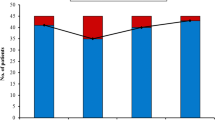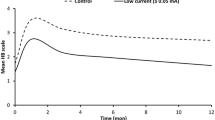Abstract
Background
Despite routine use of intraoperative neuromonitoring in acoustic neuroma removal, its application in predicting long-term facial function is limited.
Methods
Prospective recording of facial nerve function and subsequent review of intraoperative neurophysiologic data. Stimulation of the facial nerve was performed proximal and distal to the tumor locus after tumor removal with measurement of amplitude and latency responses in the orbicularis oculi and oris muscles. Prospective review of current facial nerve function was performed using the House–Brackmann (HB) scoring system. Good facial function was determined as HB I/II and HB III–VI was considered poor facial function. Minimum follow-up time was 15 months, and averaged 40 months.
Results
Twenty-four grade IV acoustic neuromas (54 % larger than 4 cm) were completely removed from October 2008 to November 2013. Nine patients (37.5 %) had HB I/II and 15 (62.5 %) had HB III–VI. The poor prognosis group had a higher latency than the good prognosis group (p = 0.045). Lower proximal amplitude was detected in the poor prognosis group (p = 0.046). Lower proximal-to-distal amplitude ratio was also detected in the poor prognosis group (p = 0.052). Amplitude ratio cut-offs of 0.44 and 0.25 were able to predict poor prognosis with sensitivity of 0.73 and 0.4 and specificity of 0.78 and 1, respectively (p = 0.046).
Conclusions
Lower proximal amplitude and proximal-distal amplitude ratio were previously reported as predictors of poor facial function in different sizes of vestibular schwannomas. We observed that the same applies specifically for large-sized, completely removed, grade IV tumors. Additionally, we describe a difference in proximal latency time between the good and poor prognosis groups, which was not previously reported.



Similar content being viewed by others
References
Acioly MA, Liebsch M, de Aguiar PH, Tatagiba M (2013) Facial nerve monitoring during cerebellopontine angle and skull base tumor surgery: a systematic review from description to current success on function prediction. World Neurosurg 80:e271–e300
Arnoldner C, Mick P, Pirouzmand F, Houlden D, Lin VY, Nedzelski JM, Chen JM (2013) Facial nerve prognostication in vestibular schwannoma surgery: the concept of percent maximum and its predictability. Laryngoscope 123:2533–2538
Axon PR, Ramsden RT (1999) Intraoperative electromyography for predicting facial function in vestibular schwannoma surgery. Laryngoscope 109:922–926
Bernat I, Grayeli AB, Esquia G, Zhang Z, Kalamarides M, Sterkers O (2010) Intraoperative electromyography and surgical observations as predictive factors of facial nerve outcome in vestibular schwannoma surgery. Otol Neurotol 31:306–312
Bozorg Grayeli A, Kalamarides M, Fraysse B, Deguine O, Favre G, Martin C, Mom T, Sterkers O (2005) Comparison between intraoperative observations and electromyographic monitoring data for facial nerve outcome after vestibular schwannoma surgery. Acta Otolaryngol 125:1069–1074
Darrouzet V, Martel J, Enee V, Bebear JP, Guerin J (2004) Vestibular schwannoma surgery outcomes: our multidisciplinary experience in 400 cases over 17 years. Laryngoscope 114:681–688
Harner SG, Daube JR, Beatty CW, Ebersold MJ (1988) Intraoperative monitoring of the facial nerve. Laryngoscope 98:209–212
Harner SG, Daube JR, Ebersold MJ, Beatty CW (1987) Improved preservation of facial nerve function with use of electrical monitoring during removal of acoustic neuromas. Mayo Clin Proc 62:92–102
Hone SW, Commins DJ, Rames P, Chen JM, Rowed D, McLean A, Nedzelski JM (1997) Prognostic factors in intraoperative facial nerve monitoring for acoustic neuroma. J Otolaryngol 26:374–378
House JW, Brackmann DE (1985) Facial nerve grading system. Otolaryngol Head Neck Surg 93:146–147
Isaacson B, Kileny PR, El-Kashlan HK (2005) Prediction of long-term facial nerve outcomes with intraoperative nerve monitoring. Otol Neurotol 26:270–273
Kombos T, Suess O, Kern BC, Funk T, Pietila T, Brock M (2000) Can continuous intraoperative facial electromyography predict facial nerve function following cerebellopontine angle surgery? Neurol Med Chir (Tokyo) 40:501–505, discussion 506–507
Koos WT, Day JD, Matula C, Levy DI (1998) Neurotopographic considerations in the microsurgical treatment of small acoustic neurinomas. J Neurosurg 88:506–512
Koos WT, Spetzler RF, Lang J (1993) Color Atlas of Microneurosurgery, ed2
Lownie SP, Drake CG (1991) Radical intracapsular removal of acoustic neurinomas. Long-term follow-up review of 11 patients. J Neurosurg 74:422–425
Lye RH, Dutton J, Ramsden RT, Occleshaw JV, Ferguson IT, Taylor I (1982) Facial nerve preservation during surgery for removal of acoustic nerve tumors. J Neurosurg 57:739–746
McClelland S 3rd, Guo H, Okuyemi KS (2011) Morbidity and mortality following acoustic neuroma excision in the United States: analysis of racial disparities during a decade in the radiosurgery era. Neuro Oncol 13:1252–1259
Moffat DA, Parker RA, Hardy DG, Macfarlane R (2014) Factors affecting final facial nerve outcome following vestibular schwannoma surgery. J Laryngol Otol 128:406–415
Morton RP, Ackerman PD, Pisansky MT, Krezalek M, Leonetti JP, Raffin MJ, Anderson DE (2011) Prognostic factors for the incidence and recovery of delayed facial nerve palsy after vestibular schwannoma resection. J Neurosurg 114:375–380
Neff BA, Ting J, Dickinson SL, Welling DB (2005) Facial nerve monitoring parameters as a predictor of postoperative facial nerve outcomes after vestibular schwannoma resection. Otol Neurotol 26:728–732
Niparko JK, Kileny PR, Kemink JL, Lee HM, Graham MD (1989) Neurophysiologic intraoperative monitoring: II. Facial nerve function. Am J Otol 10:55–61
Nissen AJ, Sikand A, Curto FS, Welsh JE, Gardi J (1997) Value of intraoperative threshold stimulus in predicting postoperative facial nerve function after acoustic tumor resection. Am J Otol 18:249–251
Prell J, Rampp S, Romstock J, Fahlbusch R, Strauss C (2007) Train time as a quantitative electromyographic parameter for facial nerve function in patients undergoing surgery for vestibular schwannoma. J Neurosurg 106:826–832
Prell J, Strauss C, Rachinger J, Alfieri A, Scheller C, Herfurth K, Rampp S (2014) Facial nerve palsy after vestibular schwannoma surgery: dynamic risk-stratification based on continuous EMG-monitoring. Clin Neurophysiol 125:415–421
Rinaldi V, Casale M, Bressi F, Potena M, Vesperini E, De Franco A, Silvestri S, Zini C, Salvinelli F (2012) Facial nerve outcome after vestibular schwannoma surgery: our experience. J Neurol Surg B Skull Base 73:21–27
Roland JT Jr, Fishman AJ, Golfinos JG, Cohen N, Alexiades G, Jackman AH (2004) Cranial nerve preservation in surgery for large acoustic neuromas. Skull Base 14:85–90, discussion 90–81
Romstock J, Strauss C, Fahlbusch R (2000) Continuous electromyography monitoring of motor cranial nerves during cerebellopontine angle surgery. J Neurosurg 93:586–593
Ryzenman JM, Pensak ML, Tew JM Jr (2004) Patient perception of comorbid conditions after acoustic neuroma management: survey results from the acoustic neuroma association. Laryngoscope 114:814–820
Samii M, Gerganov VM, Samii A (2010) Functional outcome after complete surgical removal of giant vestibular schwannomas. J Neurosurg 112:860–867
Samii M, Matthies C (1997) Management of 1000 vestibular schwannomas (acoustic neuromas): surgical management and results with an emphasis on complications and how to avoid them. Neurosurgery 40:11–21, discussion 21–13
Schmitt WR, Daube JR, Carlson ML, Mandrekar JN, Beatty CW, Neff BA, Driscoll CL, Link MJ (2013) Use of supramaximal stimulation to predict facial nerve outcomes following vestibular schwannoma microsurgery: results from a decade of experience. J Neurosurg 118:206–212
Selesnick SH, Carew JF, Victor JD, Heise CW, Levine J (1996) Predictive value of facial nerve electrophysiologic stimulation thresholds in cerebellopontine-angle surgery. Laryngoscope 106:633–638
Selesnick SH, Goldsmith DF (1993) Issues in the optimal selection of a cranial nerve monitoring system. Skull Base Surg 3:230–239
Silva J, Cerejo A, Duarte F, Silveira F, Vaz R (2012) Surgical removal of giant acoustic neuromas. World Neurosurg 77:731–735
Sobottka SB, Schackert G, May SA, Wiegleb M, Reiss G (1998) Intraoperative facial nerve monitoring (IFNM) predicts facial nerve outcome after resection of vestibular schwannoma. Acta Neurochir (Wien) 140:235–242, discussion 242–233
Strauss C, Romstock J, Fahlbusch R, Rampp S, Scheller C (2006) Preservation of facial nerve function after postoperative vasoactive treatment in vestibular schwannoma surgery. Neurosurgery 59:577–584, discussion 577–584
Sughrue ME, Kaur R, Kane AJ, Rutkowski MJ, Kaur G, Yang I, Pitts LH, Parsa AT (2010) The value of intraoperative facial nerve electromyography in predicting facial nerve function after vestibular schwannoma surgery. J Clin Neurosci 17:849–852
Sughrue ME, Yang I, Rutkowski MJ, Aranda D, Parsa AT (2010) Preservation of facial nerve function after resection of vestibular schwannoma. Br J Neurosurg 24:666–671
Taha JM, Tew JM Jr, Keith RW (1995) Proximal-to-distal facial amplitude ratios as predictors of facial nerve function after acoustic neuroma excision. J Neurosurg 83:994–998
Talfer S, Dutertre G, Conessa C, Desgeorges M, Poncet JL (2010) Surgical treatment of large vestibular schwannomas (stages III and IV). Eur Ann Otorhinolaryngol Head Neck Dis 127:63–69
Tos M, Stangerup SE, Caye-Thomasen P, Tos T, Thomsen J (2004) What is the real incidence of vestibular schwannoma? Arch Otolaryngol Head Neck Surg 130:216–220
Turel MK, Babu KS, Singh G, Chacko AG (2014) The utility of facial nerve amplitude and latency ratios in predicting postoperative facial nerve function after vestibular schwannoma surgery. Neurol India 62:178–182
Yetiser S, Karapinar U (2007) Hypoglossal-facial nerve anastomosis: a meta-analytic study. Ann Otol Rhinol Laryngol 116:542–549
Yingling CD, Gardi JN (1992) Intraoperative monitoring of facial and cochlear nerves during acoustic neuroma surgery. Otolaryngol Clin North Am 25:413–448
Yokoyama T, Uemura K, Ryu H (1991) Facial nerve monitoring by monopolar low constant current stimulation during acoustic neurinoma surgery. Surg Neurol 36:12–18
Youssef AS, Downes AE (2009) Intraoperative neurophysiological monitoring in vestibular schwannoma surgery: advances and clinical implications. Neurosurg Focus 27, E9
Acknowledgments
The authors thank Hélio Alves for the support provided in the statistical analysis.
Conflict of interest
None.
Author information
Authors and Affiliations
Corresponding author
Additional information
Comment
The authors have examined the predictive value of intraoperative monitoring in 24 large acoustic neuromas (grade IV). They graded postoperative facial nerve function with the House–Brackmann scoring system. Analysis was done via ANOVA comparing HB score to several neurophysiological values measured intraoperatively—37.5 % of their group had a good outcome (HB 1/2) and 62 % had poor facial function. The main result is the description of amplitude and latency of facial nerve stimulation responses measured proximal and distal of the tumor. They defined certain characteristics typical for the poor prognosis group such as lower proximal amplitude, lower proximal-to-distal amplitude ratio, and amplitude ratio cut-offs. These results have previously been described for smaller schwannomas and the authors claim for the first time that they now have found a difference in proximal latency time between the good and poor prognosis group, previously not reported. It seems to me that one of the purposes of the study is to find out the predictive value of these intraoperative observations for postoperative facial nerve function, which is described by the authors to be poor.
Johannes Schramm
Bonn, Germany
Rights and permissions
About this article
Cite this article
Duarte-Costa, S., Vaz, R., Pinto, D. et al. Predictive value of intraoperative neurophysiologic monitoring in assessing long-term facial function in grade IV vestibular schwannoma removal. Acta Neurochir 157, 1991–1998 (2015). https://doi.org/10.1007/s00701-015-2571-9
Received:
Accepted:
Published:
Issue Date:
DOI: https://doi.org/10.1007/s00701-015-2571-9




